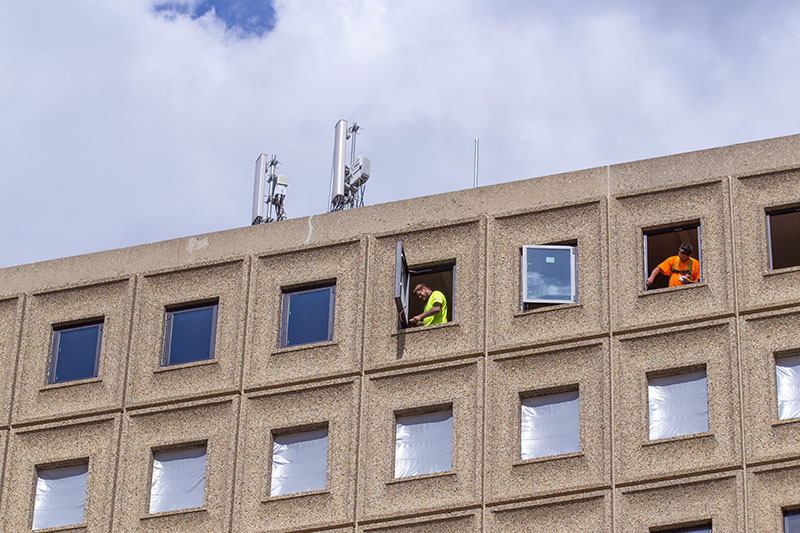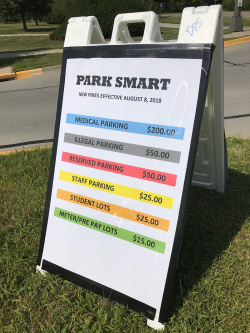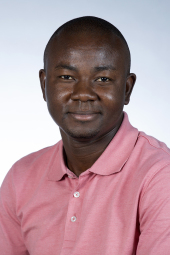Clear views

A three-year window replacement project at Friley Hall started this summer. Photos by Christopher Gannon.
Many students moving into the Towers and Friley residence halls this fall will be greeted with clear views of campus through brand-new windows. The department of residence is investing more than $9 million in window replacements at the two locations, with work phased over the summer months.
At the Towers, 1,280 windows were replaced the last two summers -- 640 each in the 10-story Wallace and Wilson halls. The $4.4 million project wrapped up this year.
A three-year schedule of window replacements kicked off this summer at Friley Hall, with completion scheduled for 2020. Work began at the west end of Iowa State's largest residence hall, installing an estimated 555 of the $4.9 million project's 2,000-plus windows.

Crews wrapped up the two-phase replacement project at Wallace and Wilson halls this summer.
Workday testing ramps up this month
Learn more about WorkCyte
WorkCyte team members are gearing up to run scenarios specific to Iowa State's financial, payroll and human capital management processes. It's the next step in the testing phase for the Workday software platform that's been configured for ISU and will go live July 1, 2019.
End-to-end testing will put the Workday system through the actions required for day-to-day processes. Test scenarios will vary, many with multiple actions required.
"We're basically writing the story of all the actions and tasks that are taking place, trying to anticipate those day-to-day activities and test them against the system built for Iowa State," Kristen Constant, interim vice president and chief information officer.
The scenarios will take processes from start to finish and include variations. For example, different steps may be required to hire merit, faculty, staff and student employees. And what steps are needed for employees who retire or leave ISU?
"All of those end-to-end lifecycle processes are what we'll test over the next few months," Constant said.
Other common processes include:
- Purchasing and ordering
- Vacation and sick leave
- Travel and expense reimbursements
- Research grant management
- Payroll and benefits management
- Tax reporting
- New employee onboarding
Team effort
About 130 ISU employees will be involved in the end-to-end testing that begins Aug. 20, with completion by the end of November. Constant said the WorkCyte team will log issues, work to resolve them and then retest until all the wrinkles are ironed out.
"There's a tremendous amount of work being done," she said. "This broad end-to-end testing covers all of the functionality we'll go live with."
Once the overall end-to-end testing is done, the WorkCyte team will turn its focus in December to payroll -- comparison testing of the Workday and current systems.
"This payroll parallel testing confirms that the new system produces payroll accurately," Constant said.
Parking changes now in effect
Eliminating free visitor parking during business hours and raising fines for violations should help clear spaces paid for by permit holders. Mark Miller, director of the parking division, said the changes are aimed at compliance, rather than generating revenue.
"We don't want to give tickets," Miller said. "The last two times we've raised fines, the revenues have dropped."
He said permit holders get frustrated when unauthorized vehicles park in their spaces, something the university's transportation advisory council took into consideration.
"Our advisory council weighed in and made the recommendation to raise the rates," Miller said. "We want to make sure that people who are paying for the privilege have a place to park."
Park Smart

About two dozen sandwich boards have popped up around campus to remind drivers to "Park Smart" and avoid parking fines. As of Wednesday, Aug. 8, citations increased to:
- $15 for expired meters and prepaid stalls, an increase of $5
- $25 in student and general staff lots, an increase of $10
- $50 in reserved lots and stalls, an increase of $20
- $50 for illegal parking (for example, along yellow curbs or in fire lanes), an increase of $10
- $200 in medical accessible locations, which mirrors the state-mandated penalty
More information and a complete list of fines is available on the parking division website.
Visitor permits
Visitor parking permits, free prior to July 1, cost $5 daily for a maximum of five days. Visitors can use the online form to purchase and print a permit. Miller said his staff can assist departments with online visitor permit requests.
"Some campus departments have reserved parking spaces they already use for their visitors," Miller said.
Miller said metered stalls are being added in some lots -- for example, near the Environmental Health and Services Building and the Applied Sciences complex -- to provide an option for short-term visits.
"There are a lot of options. We also try to make sure people know there is free parking at the Iowa State Center, with a free CyRide bus route onto campus," Miller said.
Visitor permits are valid only in the general staff (7 a.m. to 5:30 p.m. weekdays) and student parking lots (all hours, all days). Many campus lots are open for free parking on weeknights and weekends. If a citation is issued, visitors get one "visitor void" in their lifetime. Citations for medical, illegal or unauthorized parking violations will not be voided. Visitor voids are not available for use by faculty, staff and students.
"We understand that our policies can be a little confusing if you haven't been on campus before," Miller said. "As long as you didn't park illegally or in a medical stall, we'll take back one ticket and provide you with information about how to get a permit in the future."
Donated leave policy expands to family illness and injury
Under a recently adopted policy change, Iowa State faculty and staff can receive donated paid leave from other university and state employees to care for a family member who is seriously hurt or sick. The change expands the pre-existing policy that allows employees suffering from a catastrophic injury or illness to accept leave donations from co-workers.
The change is effective as of Aug. 1, said Ed Holland, benefits director for university human resources (UHR). Expanding the policy to cover a family member's medical emergency aligns with Iowa State's strategic plan and the policies of other state Board of Regents institutions.
Eligibility requirements are similar to the pre-existing policy. The recipient must have no vacation or emergency leave available, and the family member's illness or injury must require the employee to miss work for at least 30 consecutive days. Qualifying family members are those covered under the federal Family and Medical Leave Act -- spouses or partners, children and parents.
To seek approval to receive donated leave, potential recipients must fill out specific forms for their own illness or injury and for the illness or injury of a family member.
Here's how it works if the donation request is approved: The employee's departmental human resources liaison will inform colleagues in the college or department that the employee is requesting donated leave. The department or the employee also can pass along the request to others, though the university doesn't send centrally solicit or post requests.
Donors also fill out different forms to contribute vacation leave for an employee's own illness or to care for a family member. The recipient's department will collect donations and forward them to UHR. Donations must be made in hourly increments. The actual financial value of the vacation time will transfer for Iowa State donors. Donations from other state workers are on an hour-for-hour basis. The source of donations will remain anonymous.
For more information, check out UHR's website for leave and absence policies.
With first full-time coordinator, recycling set to expand
Across most of campus, throwing trash away is easier than recycling. Ayodeji Oluwalana plans to flip that script, making recycling the default as part of a new initiative aimed at eventually preventing nearly all of Iowa State's waste from heading toward a landfill. Soon, for instance, that may mean a recycling bin will be the only disposal option in classrooms and at office desks.
Oluwalana is the first full-time recycling coordinator for facilities planning and management (FPM), a job he began in June. He has spent the summer assessing campus recycling efforts and meeting with key staff, such as custodial teams. His verdict?

Ayodeji Oluwalana
Starting this fall, ISU recycling will shift from survival to expansion."What I've seen so far, and from what folks have told me, I think recycling at ISU has been in survival mode," he said.
Zero-waste goal
The goal is to be a zero-waste campus by 2025, Oluwalana said. That wouldn't mean Iowa State creates no trash. The university would be zero-waste if it established all possible means to keep refuse out of the garbage stream. While it's not realistic to divert everything, 90 percent is possible, Oluwalana said.
To work toward that, Oluwalana will be conducting a yearlong pilot project in a handful of high-traffic buildings beginning this fall -- the Gerdin Building for sure, with others yet to be identified. He'll test several tactics, including an increase in recycling bins, more visual and coordinated messaging on bins, signs encouraging recycling and classrooms without trash cans.
"With the right messaging, with the right engagement, with the right signage, people will be able to do the right thing," Oluwalana said.
Boosting recycling was the goal in hiring a full-time coordinator, FPM facilities services director Bob Currie said. While blue recycling bins, which switched to no-sort mixed-stream in 2015, have been a familiar sight at faculty and staff desks for decades, students especially have limited options, Currie said.
Still, employees will play a role in recycling's resurgence. FPM's General Services Building will serve as a guinea pig this school year for taking trash cans away from desks, freeing up custodial staff to pick up recyclable materials from desk bins instead of trash. There will be centralized trash containers available for refuse bound for the city's Resource Recovery System, which burns what garbage it can as power plant fuel before sending the rest to a landfill.
Standard approach
Oluwalana will use feedback from the pilot projects -- and meetings with stakeholders over the next year -- to fine-tune uniform signs and designs for campus recycling receptacles.
"Anybody should be able to picture the materials that go into those bins," he said.
Coordinated messaging could help reduce contamination in recycling bins, which can cost the university extra fees charged by its recycling hauler, he said. Part of that coordination will be an interactive and informational website for the recycling program.
After an initial focus on indoor recycling, Oluwalana plans to tackle the availability outdoors, as well. There are just a few recycling spots along campus paths, he said.
Other steps
The university's waste-reduction efforts will extend beyond better bins and more strategic communication, though.
Oluwalana hopes to streamline and strengthen the contracts and procurement that impact recycling. Consolidating waste management contracts for all university units and requiring the vendor to track how much material is removed is a key step toward determining how much refuse is being recycled, he said.
Part of Oluwalana's time will be devoted to coordinating FPM services for campus events, including those organized by student groups. This year, he'll encourage strategies to decrease waste at events by offering recycling and limiting single-use items such as disposable silverware. By the 2019-20 school year, the recommendations likely will become mandates for event authorization, he said.
Instilling recycling and waste-lessening habits in students, faculty and staff will take a long-term, cooperative effort, Oluwalana said. He plans to partner with sustainability director Merry Rankin and her Live Green team of student interns, for example. But ramping up recycling at Iowa State will require buy-in across campus, he said.
"It's a systemic approach. It's not just one entity," he said. "Once people have a sense of ownership, I think it will be a success."
Many CyRide routes will change Aug. 13
A second -- and larger -- set of changes to CyRide bus service takes effect Monday, Aug. 13. A first wave was implemented in early May. The changes are part of CyRide 2.0, a comprehensive plan to improve bus travel throughout Ames built on more than a year of study and public input.
A key change for the university community is that the College Veterinary Medicine campus no longer will be serviced by the orange route, which will continue to function as a free circulator between central campus and the Iowa State Center commuter lots. A new weekday-only route, the peach route, will traverse from Vet Med to North Grand Mall via the east part of campus, Stange Road and 24th Street.
The blue route, which previously connected north Ames to campus, now will focus only on the south portion of the route, providing service between central campus and the South Duff Avenue commercial district, via South Fourth Street.
The brown route, formerly a weekday-only route that services the ISU Research Park via the Towers residence halls, has added Saturday service all the way to the research park and Sunday service as far south as the Towers.
The gold route is a new free weekday-only circulator between Schilletter Village student apartments and the Towers residence halls via central campus. It will operate on a 10-minute interval from 10 a.m. to 6 p.m. (30-minute interval before and after that window).
Beginning Aug. 13, two new routes will provide additional service between campus and the residential area of southwest Ames popular with ISU students. The cherry route is the new name for the former red 1A route, which provides additional service, only on ISU class days, to and from campus via South Dakota Avenue and Lincoln Way. The lilac route is a weekday express option, providing service only during morning and late afternoon peak hours, from Dickinson Avenue to campus via Mortensen Road and State Avenue.
CyRide eliminated the silver route, a Sunday night shuttle from the stadium lots to the three residence hall neighborhoods, due to low rider numbers.
Riders who use CyRide's NextBus app should update their bus stops, as they've all been renumbered to coincide with the other changes.
Already in place
Key changes implemented May 5:
- Fare rollback to 2011 prices. The cash fare for a single ride is $1, down from $1.25. Bus passes for ISU faculty, staff and post docs subsidized by the ISU parking division also decreased. An academic year pass now costs $180, instead of $230.
- Drivers won't wait for a rider who is late but trying to catch a bus. With more frequent intervals on most routes, the intent is to keep routes -- and riders -- on schedule.
- In another effort to keep buses running on time, transfers will only be guaranteed at City Hall. Buses won't wait for late-arriving connecting routes on campus.
CyRide has summarized all the route changes in an online document.
Related stories
- First phase of CyRide changes is coming May 5, April 12, 2018
- Implementation planning begins for CyRide route changes, May 18, 2017
Baldwin named assistant VP in student affairs

Erin Baldwin has been named assistant vice president for student health and wellness in the student affairs division, effective Aug. 8. Baldwin, who has served as interim in the position since Oct. 2, 2017, also is director of Thielen Student Health Center and will continue in both roles. As assistant vice president for student health and wellness, Baldwin is responsible for developing a holistic, multidisciplinary approach to student health and well-being for a growing and diverse student population. Duties include oversight of the Thielen Student Health Center, student counseling services, the student wellness office and recreation services.
"Student health and well-being are inextricably linked to student academic success, retention and persistence to graduation," Baldwin said. "I am honored to have the opportunity to support our students, health and wellness team, and campus partners as we strive for a campus culture of holistic wellness."
Before coming to Iowa State, Baldwin was chief operating officer for the Mahaska Health Partnership in Oskaloosa. She has senior leadership experience in provider-based clinics, pharmacy, lab, radiology, physical and occupational therapy, food and nutrition services, behavioral health services and public health. She earned a bachelor’s degree in respiratory care at the University of Kansas (2003) and master’s degrees in health care administration and public health from the University of Iowa (2006).
"As the director for the Thielen Student Health Center, Erin has transformed the center into a department that delivers high quality, holistic and comprehensive care to our students," said Martino Harmon, senior vice president for student affairs. "Throughout each challenge and each new role, I have been impressed with Erin’s professionalism, commitment to higher education and desire to help students succeed."
Baldwin also will continue to serve as interim director of student counseling services during the search for a replacement. Former director Joyce Davidson moved into the role of special projects director for student health and wellness on June 11.
P&S Council identifies priorities for coming year
The Professional and Scientific Council set its sights on seven strategic initiatives to pursue in 2018-19.
At a July meeting, council members in breakout groups brainstormed potential priorities, which were then grouped into categories by the council's executive committee and presented at the council's Aug. 2 meeting. The council, which sets priorities annually, will consider approving the list at its Sept. 6 meeting.
Possible action items suggested by councilors were forwarded to council committees and vice presidents for consideration but weren't publicly shared.
The strategic initiatives are:
- Advocating for competitive compensation
- Enhancing performance evaluations
- Improving professional development opportunities
- Supporting more training for supervisors
- Building on employee engagement efforts
- Highlighting value of P&S staff and their importance in shared governance
- Creating environments where workers feel valued, welcomed and included
